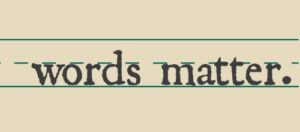
“Language is the greatest motivating force. You can phrase something positively and inspire people to do their best, or negatively and make them feel worried, uncertain and self -conscious. I try to use my own voice in a way that shows caring, respect, appreciation and patience.” – Frances Hesselbein, former Girls Scouts CEO, founder Hesselbein Leadership Forum.
I’m a student of leadership.
I’m fascinated by the subject and believe that good leadership can solve nearly any problem, seize any opportunity and overcome any challenge.
Consequently, bad leadership (there’s an oxymoron for you) or lack of leadership can sink just about any ship regardless of how strong the hull.
When you achieve a position of leadership you quickly learn that words matter.
Unless of course you are lack emotional intelligence and either don’t care about how you communicate or don’t realize that your words carry extra weight. (We’ve all seen our share of those beauties).
Based on my study of effective leaders, the ones who use positive language to frame challenges and opportunities are usually the ones who get the best results.
Positivity is a strong motivator.
I’ve seen fear used as well.
Bullies will get short term results, but their “leadership” doesn’t sustain.
Leaders who show that they care, respect and appreciate those who they serve are special. They get results. They transform. We need more of them. A lot more of them.
I’ve worked with and seen organizations decimated by egotistical narcissists who think that people are there to serve them. They got it backwards and that mindset is crushing.
You can see the arc of destruction if you watch closely.
The bully/egomaniac is given a title and a little power and it goes to their head. They tend to put themselves on a perch and “sit above” the organization they are tasked to lead. Problems are never their fault, instead they seek to blame, point fingers and inject fear into the culture.
At this point, people with options resist and or leave and those who feel powerless stop taking risks or hide in hopes of outlasting the tyrant with the title.
What’s lost when this happens is incalculable—initiative, innovation, creativity, productivity and your organization’s desirability as a place to work or invest. It isn’t pretty.
What’s worse is the damage inflicted by bad leaders can have an outsize impact on the future of the enterprise.
Of course, this dynamic applies to cities as well.
When it comes to cities, there’s a term called “municipal math.” I believe the term was coined by Lyle Sumek, a consultant who works with Boca Raton and used to work with Delray Beach.
As Lyle explained to us—municipal math meant that it takes 10-20 years to build something of significance but only a year or two to wash away progress. It can take 10 years to get it back and there’s no guarantee that you will.
It’s a daunting equation and Lyle offered up it up as a cautionary tale. Feel free to innovate and lead, he urged us. But tread prudently, because at the end of the day you are a steward so don’t screw up what was handed to you.
So disrupt what doesn’t work, fix, create and put your stamp on your city, non-profit, business or industry but have some humility too. Your task as a leader to leave your organization better off than when you found it and in position for the next leader to take the enterprise even further.
Don’t act as if you’re the last monarch—you aren’t. In fact, don’t act like a monarch at all.
Serve.
Educate.
Lead.
And leave things better for the next generation.


